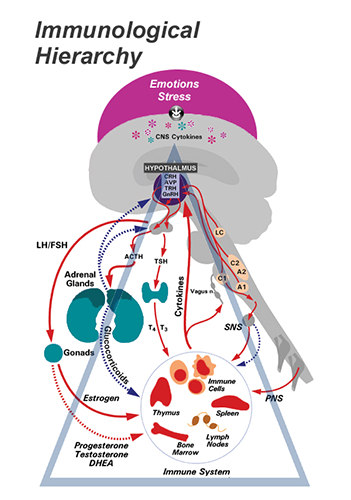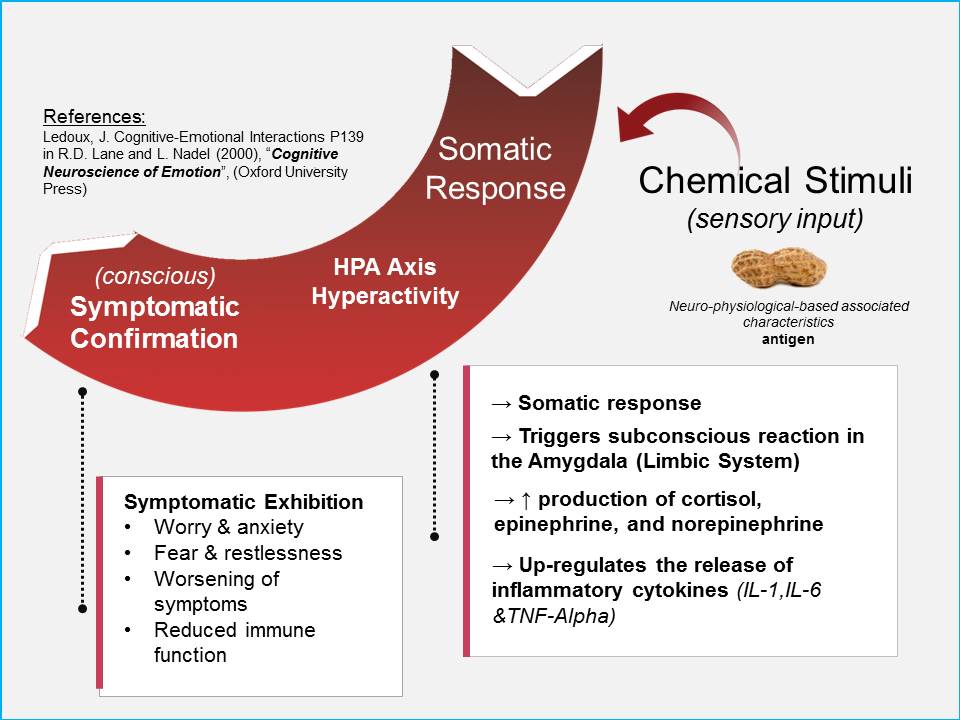Medicine is starting to acknowledge the tight coupling of mind and body, and how thoughts, emotions, and stress can trigger biochemical responses that impact health. Studies into the psycho-neuro-endocrine-immunological level (PNEI) (or mental level) allow us to better understand the pathway that carries signals which trigger specific biophysical actions. Signaling pathways at this level are responsible for the activation of T-cells, B-cells, natural killer (NK) cells, and macrophages – all of which play a critical role in immune function and each individual’s reaction to the presence of certain pathogenic, environmental, or even psycho-emotional triggers.
Mounding evidence now exists in this field of study which clearly demonstrates and delineates the precise pathways and processes that lead from thoughts, belief systems, and programs in the mind to biochemical actions and symptoms in the body. Understanding the role of the PNEI system, the HPA axis and immunological hierarchy offer great insight into medicine’s most prominent questions, such as why patients respond differently in the face of the same triggers.
The Immunological Hierarchy

How can the idea that thoughts have an impact on the body be explained by a physician? According to Dr. Peter Schleicher, the renowned immunologist from Munich who has worked with European Biological Medicines for many years shows that this idea of thoughts impacting physiology has been around for centuries. In his opinion, the healing practitioners of old had their own way of understanding the inter-relationship between the complex regulatory mechanisms affecting the emotions, the secretions from the hormonal glands, and the immunological system, and this has only recently been re-discovered by modern scientists. Furthermore, this notion has been mapped out into a hierarchy, delineating how emotions and stress create a cascade of effects and impact several regulatory mechanisms.
As reported by immunological findings, these various regulation mechanisms, which comprise the psycho-neuro-endocrine-immune system, are connected to each other in pyramid-like hierarchies. At the top of this immunological hierarchy are the emotions which relate to limbic activity, then the level of the hypothalamus and pituitary gland, which is followed by the regulation systems influencing the thyroid gland, and finally, at the base of the pyramid, is the functional source that comes from the gonads (the sexual organs) and the adrenal glands. “All of our immune cells are in direct communication with each other, and our immune system is harmoniously nestled within the laws of the cosmos”, emphasizes Dr. Schleicher. According to the immune specialist’s experience, all levels of this hierarchy can be given regulatory impulses through proper medical solutions that can impact the psycho-emotional level of the patient.
An Example – Peanut Allergy
Using the example of a peanut allergy as a trigger for dysfunction, we can illuminate how the mind play’s an important role in the symptomatic response. In this common scenario, the antigen enters the system, making its way to the lymph nodes where it triggers the IgE mediated immune response. Primary mediators and inflammatory cytokines released during the histamine reaction lead to allergic symptoms including skin irritation, hives, swelling, and a wide array of others. But this is only the beginning of the commonly understood biochemical actions of a peanut allergy.
To understand why the body responds this way in the first place, we need to move on to the level of the mind, or the PNEI system and see how things unfold along the immunological hierarchy. The conventional definition of an allergy is an exaggerated immune response or reaction to substances, even though absent any severe contaminants, a peanut is generally a benign substance. In a more advanced understanding, an allergen is a substance that the brain views as a threat and that causes energy blockages in meridians. This is how it plays out on the PNEI level (level of the mind), where the normally benign substance is perceived as a chemical stimulus imbued with specific neurophysiological associated characteristics that effectively make it an antigen. In other words, the stimuli are acting in the same way as a stressful thought, only now unfolding as a subconscious trigger. The resulting somatic response we witnessed on the biochemical level, now acts as the trigger to up-regulate Hypothalamic-Pituitary-Adrenal (HPA) axis activity, which increases chemical activity and perpetuates further symptoms.

PNEI -> Allergen “conditioning” cycle -> Symptoms
- Somatic response
- Triggers a subconscious reaction in the Amygdala (Limbic System)
- Stimulates production of cortisol, epinephrine, and norepinephrine (adrenalin)
- 5 Up-regulates release of inflammatory cytokines (IL-1, IL-6 & TNF-Alpha) – due to local inflammation
- Cascade of biochemical, hormonal and neurotransmitter metabolic, cellular dysfunction – affecting T-cells, B-cells, NK cell and Macrophages
- Increased general inflammation, antibody production, antigen breakdown + histamine
- Further symptoms
Want a further breakdown of this example? Watch the video below:
[av_video src=’https://vimeo.com/85176685′ format=’16-9′ width=’16’ height=’9′ av_uid=’av-1bl7833′]
Why This All Matters
This immunological hierarchy doubled with the understanding of the PNEI level and HPA axis, now scientifically shows us our health is inextricably linked to our thoughts and emotions – whether they be conscious thoughts we experience everyday or subconscious belief systems that have been running in the background your whole life. This vital discovery confirms the need for medicine to not just focus on the biochemistry of a patient, but the psycho-emotional state and the way a patient thinks.
“Body and soul cannot be separated for purposes of treatment, for they are one and indivisible. Sick minds must be healed as well as sick bodies.”
~ C. Jeff Miller.
Tips to Change Negative Thoughts into Positive Ones
- Pay Attention to Your Thoughts: Be aware of your thoughts as they happen. Some of us go into auto drive and negative thoughts seem to take over our day. When a negative or stressful thought runs through your head, cancel it out. Stop yourself in your tracks, and say to yourself, ‘this is a false thought, and I do not accept it. I control my thoughts and choose to think positive.’
- Practice Meditation: Rather than trying to stop every negative thought that comes up, another technique is to calm the mind altogether and reduce the number of thoughts you have. Meditating as few as 10 minutes each day can help you control stress, reduce negative thoughts, decrease anxiety, improve cardiovascular health, and achieve a greater capacity for relaxation. Try our free
- Increase Positivity through Gratefulness: A sure way to increase positivity is through practicing gratefulness. Easy ways to do this is through keeping a gratefulness journal (we recommend the ‘The Five Minute Journal: A Happier You in 5 Minutes a Day‘), or simply being mindful of all the people around you that help you and showing gratefulness to them. That includes construction crews that make driving on streets and getting around possible, delivery people that make getting things you want or need easier, or the store clerk that allows you to purchase the nutritious foods that sustain you. Simply wishing them happiness and thanking them in your head can trigger the release of positive hormones and endorphins and produce a more positive attitude.
- Ho’oponopono: This is an ancient Hawaiian self-transformation technique for healing and an effective spiritual therapy. The basic principle is that through the technique, one can release belief systems in the subconscious mind that act as present day stressors. It is considered a ‘cleaning’ practice, and helps free oneself from their negative feelings and emotions to erase from their memory or consciousness the negative cycle that is detrimental to optimal healing.
The bottom line of all this is: more positive thoughts and emotions we have, the healthier we are. We now have the science to back it.





